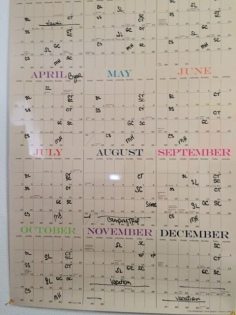One of the things I do each month with my Digital Dining Room group is host a Secret Supper.
If I were an actual chef (and not just a metaphorical one), those Secret Suppers would be intimate gatherings in my kitchen where I’d show my guests exactly how I make my Signature Dishes.
Instead, my Secret Suppers are held via Google Hangouts.
For 45 minutes, I share my experiments, processes, and outcomes about that month’s specific topic (everything from social media strategy to copy writing).
They get to see why I choose to do things the way I do. Always with the caveat that they’ll need to experiment and find their own best ways.
Because here’s the truth: my recipes won’t work precisely the same way in a different kitchen.
(Remember that the next time you’re tempted to purchase someone’s “blueprint to six figures.”)
That doesn’t mean we shouldn’t share our how-we-do-it stories. They can be incredibly beneficial to others looking to find their way through the maze of entrepreneurial success.
So that’s what we’re doing here today: taking a look at how in the world I’ve kept my arms around several major projects over the last few years (all while serving private clients):
- Word Carnivals :: a monthly group blogging project that began in 2011 and continues today (now with the guidance and cat-wrangling of Nick Armstrong).
- A Marketing & Solopreneurs Research Project :: a major survey that collected data from nearly 1200 respondents.
- Small Biz Branding Competition :: a search for the best branding done by a micro biz owner, and judged by three major branding experts (plus me).
- Attract and Feed a Hungry Crowd :: the writing, publishing, and marketing of my first book; and selling over 5,000 copies on Amazon the first year.
- Prosperity’s Kitchen :: a 14-week reality web series/competition that included 12 special guest mentors, 15 public competitors, and a play-at-home version.
- Digital Dining Room :: a year-long group coaching program that evolved from Prosperity’s Kitchen.
- Rebranding from The Word Chef to Story Bistro :: and figuring out how to
- Bloggers Mastermind :: a 6-week group program I led 5x this year.
- Sunday Brunch :: a bi-monthly informal discussion on various topics via a private Facebook group.
- Bloom Your Online Relationships :: a 30-day challenge that included 25 leaders, nearly 700 participants, and resulted in a published book.
- Story Circles :: bi-monthly in-person meetups that allow entrepreneurs to practice telling their business stories.
- Butter & Beast :: a series of stories and recipes for entrepreneurs brought to you by 12 food-loving biz owners.
Whew! That’s a lot of stuff. (Kinda makes my head spin when I see it all there in one place.)
It’s important to remember that…
- When I started The Word Chef, Mr. Perfect worked long hours and I had no children living at home.
- I have nearly 30 years of experience in directing and managing big marketing campaigns and major events.
- While I did most of the heavy lifting on the above projects, I had the help of many, MANY colleagues and readers.
- And while I DID learn my marketing chops way before the Internet was a Thing (meaning, I’ve had to learn a whole lot about the digital world, just like you), I haven’t tried to master every flipping corner of it.
So how do I keep it all humming?
The Story Bistro Back-of-House Planning System
1. Start with a Plan.
I help my clients plan their marketing the same way I plan mine: by starting with a revenue goal. How much money would I like to create in the coming year? And how would I like to create it?
Then I ask: What needs to be in place in order to make that happen? Do I need to build my list? Do more in-person speaking? Focus on deepening my existing relationships?
I usually choose just two other goals for the year: one that’s operational (how can I improve my back-of-the-house systems?) and one that serves my professional development (what skills do I want to learn or improve?).
From there, it’s a matter of laying out the steps I want and need to take to get there.
2. Use a year-at-a-glance erasable calendar to manage major timing.
I’m using this one from Paper Source which is reversible so you can mount it horizontally or vertically.
What I do first is note regular, recurring meetings…meetings with clients AND with myself.
I make it a rule to spend at least 50% of my work week ON my own business. That means blocking out time to meet with myself on a weekly basis as the CEO. To review the numbers and listen to the stories they tell me about how I’m doing. To dig deep into what’s working and/or adjust strategy, if necessary.
Then I block out time for vacations. This gives me a birds-eye view of my year and shows me where I might be over-committed or have space to tackle a new project.
Once all these dates are noted, I transfer them to my Google Calendar so that I don’t double-book myself for appointments.
3. Use a monthly wall calendar to plan out content marketing.
Again, this is a Paper Source find.
Each color post-it represents a different type of content: email, blog posts, etc. All of which serve to promote — in some way — my products and services.
I use sticky notes so I can move things around if a change needs to be made. (Anyone else addicted to these?)
Ideas for future content are written on stickies and saved on a larger, easel-sized post-it that I keep above my desk.
When I decide to write something about that topic, I can move it over to my wall calendar. Easy peasy.
4. Use an automated scheduling app to manage creation of appointments.
I’m currently using Acuity Scheduling (aff link) which syncs up to my Google calendar. It keeps me sane 99% of the time (the other 1% is usually my own fault).
It’s absolutely the best $10/month you can spend.
5. Use a project management app for all client work.
I’m currently using asana and wouldn’t trade it for the world.
I use the free version but only because I don’t need the enterprise version.
6. Use a File Sharing app for client work.
Mostly, I rely on Google apps for this, but I’ve been known to lean on Dropbox (aff link), too.
A lot of the work I do with clients involves them writing and submitting their drafts to me for feedback.
Google docs has a nice option for collaborating on work that functions similar to MS Word’s track changes function. Each time I go through and make my suggestions and comments, the client is notified by email. It’s super efficient.
7. Work with a Virtual Assistant.
I have a confession: I just started working with a VA this year. When you have the technical know-how, it’s a lot easier to manage these kinds of projects yourself. You just have to have the time and space to do so.
When you don’t have those things (time, space or know-how), then you MUST hire someone else. It does you absolutely no good to spend frustrating days and weeks trying to teach yourself how to do something when you can so much more effectively hire much of it out.
Even if it’s just an hour a week, find someone who can assist you with those things that you want to delegate. I use (and highly recommend) Carmen Taggart.
8. Work with a Coach.
Just as I coach and mentor folks, I’ve got a coach of my own. The mentoring conversations I’ve had with her have helped me focus on what matters and stay accountable to my own goals.
It’s one of the most important investments in your business, but don’t hire just anyone. Look for someone whose philosophy and operations are those you’d like to emulate.
Yes, you’d like someone to push you out of your comfort zone, but not so far out that you end up heart broken and bankrupt.
9. Keep a loose grasp on your expectations.
In other words, try to give yourself a buffer zone of objectivity when it comes to your business goals and how they unfold. Nothing will ever work out exactly the way you hoped, dreamed or planned. Don’t take the bumps personally.
+++
Whatever your goals are and however you choose to achieve them, try to create good habits and repeatable processes. And don’t forget to have a life.
Did I leave out a detail you’d like to know? Got a question or tip of your own to add? Let’s continue this conversation in the comments below!
Ever wanted to peek behind the curtain? Wanna know what’s going on behind the scenes of a small business? What little inspirations, daily reminders, and hidden dangers await in the treacherous waters of working for yourself?
Check it out this month’s Word Carnival. It’s your all-access pass.












You know what’s funny…. all this digital stuff and all these apps and “productivity” tools and at the end of the day the best stinkin tool turns out to be a sticky note on the wall. In my “go digital” frenzy I got rid of my wall calendars and it’s the one thing I miss. Now I just end up printing stuff out and sticking it on the whiteboard. There is something to be said for being “off screen” and having that tangible visual. Now I’m having calendar envy and I have to go get them back!
Also, may I add a holy cow for how many projects you have done? When you list them all out like that you look pretty busy! I love that you are always experimenting with totally fun, off the beaten path stuff. I wish I had the time to just FOLLOW all your projects. I have no idea how you manage to accomplish them all. That’s a secret sauce recipe I wouldn’t mind having 🙂
Hey, you’ve got a whiteboard so you could totally draw your own calendar on it and then use sticky notes to make things colorful. Or not. I think, mostly we just need to find ways that work for US. I tried using just paper for awhile and then just digital. Clearly, I need a calendar in every format to keep me on the straight and narrow. And the secret sauce for accomplishing all this? Less done-for-you type work for clients, more group coaching/consulting. 😉
Wow, Tea, you’re an inspiration! That’s a load of projects right there. I guess one of the reasons all of them work so well is because you’re using the same techniques you share, putting you in a great position to help those who need a push. 🙂
Thanks for saying, Sharon. I suppose that’s true! Mostly tho, they were also just FUN. 🙂
I love your sticky notes and something I know I would love to do but just never got going consistently. You have truly inspired me – as always. I am at a birthing place and this post is pushing me even further. I always knew you were handling so much and you look so great doing it too, now I get it even more. THANK YOU for continuing to be a consistent inspiration..I need to be a better and more active follower for sure.
O Michelle! I love that you feel inspired here in this space with me. And yes, I’d love to have you visit more often. My wish for you in the coming year is that you take my little nugget here and let it grow inside your own heart/brain until you are inspiring yourself. The real secret to me being able to accomplish all these things is that I did what I thought would be most awesome. Not necessarily what would bring more clients or grow my bottom line. The work you do must inspire YOU, first and foremost. Sticky notes are just the frosting on top. 😉
Calendar envy. You said it Carol Lynn!
Tea, you are simply a legend. To see it through from start to finish, that is what I admire. When you look at the volume of work you have achieved, seriously that would take most people an army. Well done you and thank you too for sharing these invaluable tips about how to be a little more productive. Number 9 resonated, you have to do that, as you just never know what will bolt around the corner and send you off in another direction. And even if you have a level of self awareness to know that that has happened, it takes time and energy to get back to the original path which always looks different when you do. A zig zagging kind of life we lead! Thanks for another keeper post. As we say in Australia, this one is going straight to the pool room!
The pool room? Never heard that one before. Really happy you found this one helpful, Sandy. I think my small army comes from being raised by two VERY organized and goal-oriented parents. My dad’s nickname was “Lil General.”
Wow, I love your calendar strategies, Tea! Those are super inspirational. In fact, I might have to steal some of them.
Being able to handle that huge list of ongoing projects takes some serious skill and drive. My hat is off to you and your ability to plan things out that far in advance. That’s a big challenge that many business owners struggle with, and here you are making it look easy, as per usual. What talent, seriously!
This post is going into my bookmarks folder for sure 🙂
Glad you enjoyed this one, Molly. Honestly, it’s more about loving the project and wanting it to see the light of day than anything else. 😉
OMG. Those calendars! Those sticky notes! I MUST DO THIS IMMEDIATELY. But maybe after I move. Love this behind the scenes breakdown, Tea–thank you for sharing!
also holy cow those are all projects from THIS YEAR? woman. you are an inspiration!
LOL. No, Michelle – those are major projects since I launched The Word Chef (in 2011).
Oh okay. I feel a lot better about myself now. 😉
Thanks for saying, Michelle. Coming from the Queen of Productivity and Systems, that’s high praise indeed. 😉
Tea I love that you started with a usable plan (not those desk drawer fillers no one reads) and created a practical system to implement. I love, love, love sticky notes and do use them regularly. For my biz plan I created a magnetic board with the key components. I can move them around, take some off, and generally have the visual focus plus flexibility. You always seem to accomplish the work of 5 people so it’s great to peak behind the scenes and see how the Great and Powerful Tea makes it happen!
When I try to plot out more than a year in advance, things go horribly, horribly wrong. In fact – most of the time I just fly by the seat of my pants with just a general vision of where I want to go.
It’s not the best solution, and I could certainly improve on it, but that’s a project for 2015 😀
In general the things that keep my bistro from humming like it should are too many meetings and too much travel time, not enough time to really sit and think, distractions, email, and having to handle other people’s problems.
When I give myself distance, and stop confusing good ideas with must-do-projects, I can really enjoy myself and be productive. Separating out the things I really, really must do from the things that are really, really, fun to think about is more difficult than I’d like to admit, though.